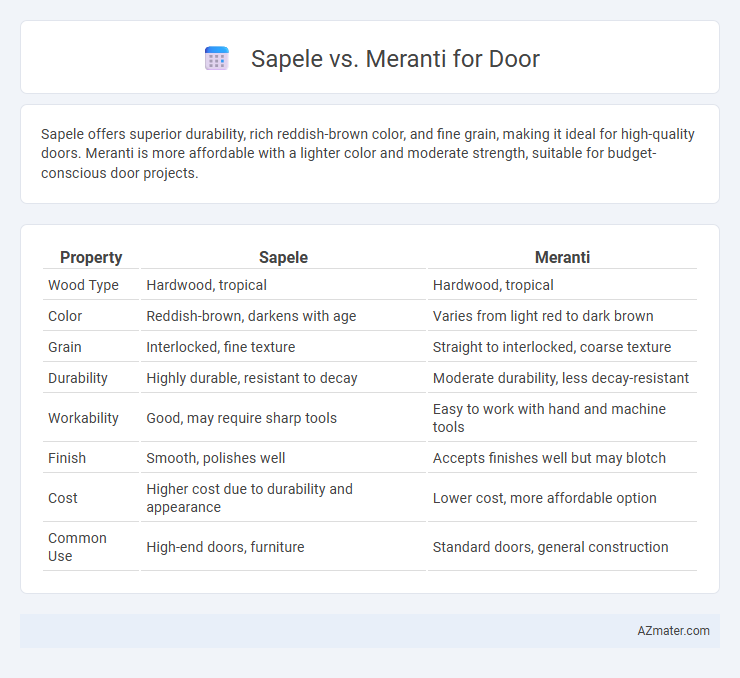Sapele offers superior durability, rich reddish-brown color, and fine grain, making it ideal for high-quality doors. Meranti is more affordable with a lighter color and moderate strength, suitable for budget-conscious door projects.
Table of Comparison
| Property | Sapele | Meranti |
|---|---|---|
| Wood Type | Hardwood, tropical | Hardwood, tropical |
| Color | Reddish-brown, darkens with age | Varies from light red to dark brown |
| Grain | Interlocked, fine texture | Straight to interlocked, coarse texture |
| Durability | Highly durable, resistant to decay | Moderate durability, less decay-resistant |
| Workability | Good, may require sharp tools | Easy to work with hand and machine tools |
| Finish | Smooth, polishes well | Accepts finishes well but may blotch |
| Cost | Higher cost due to durability and appearance | Lower cost, more affordable option |
| Common Use | High-end doors, furniture | Standard doors, general construction |
Introduction to Sapele and Meranti Wood
Sapele wood, renowned for its rich reddish-brown hue and fine grain, offers excellent durability and resistance to decay, making it a preferred choice for high-quality door construction. Meranti wood, available in various species such as Red, White, and Yellow Meranti, features a lighter color palette and moderate strength, commonly used in affordable door applications. Both woods possess good workability and finishing properties, but Sapele's superior hardness and aesthetic appeal provide enhanced longevity and elegance in door design.
Botanical Origins and Wood Characteristics
Sapele, derived from the Khaya genus native to West Africa, exhibits a rich reddish-brown hue with a fine, interlocked grain that enhances durability and aesthetic appeal for doors. Meranti, primarily sourced from the Shorea genus in Southeast Asia, offers a lighter, reddish to pale brown color with a straight to slightly interlocked grain, providing moderate strength and ease of workability. Both woods possess natural resistance to decay, but Sapele's higher density and interlocked grain make it more robust and suitable for high-traffic door applications.
Color and Grain Differences
Sapele doors feature a rich reddish-brown color that darkens with age, presenting a fine interlocking grain that produces a smooth, wavy pattern ideal for elegant finishes. Meranti doors exhibit a lighter, more uniform reddish to pale pink hue with a straight to slightly interlocked grain, offering a more subdued and consistent texture. The color vibrancy and intricate grain of Sapele make it preferred for striking door aesthetics, while Meranti is chosen for simpler, cost-effective applications with a more uniform appearance.
Durability and Strength Comparison
Sapele offers superior durability and strength compared to Meranti, making it a preferred choice for high-traffic door applications. With a Janka hardness rating of 1,410 lbf, Sapele provides enhanced resistance to dents and wear, whereas Meranti typically ranges between 980 to 1,160 lbf, indicating a softer texture. The dense grain structure of Sapele contributes to increased longevity and robustness, ensuring doors remain stable and secure in various environmental conditions.
Weather Resistance and Stability
Sapele offers superior weather resistance compared to Meranti, making it a preferred choice for exterior doors exposed to harsh climates, due to its dense grain structure and natural oils that repel moisture. Meranti, while moderately durable, tends to absorb moisture more readily, leading to potential warping and reduced stability over time. For long-lasting stability and robust performance in varying weather conditions, Sapele is generally the more reliable option.
Workability and Finishing Qualities
Sapele offers excellent workability with its fine, interlocking grain that responds well to hand and machine tools, making it ideal for intricate door designs. Meranti, while generally easier to machine due to its softer texture, can sometimes present inconsistencies in grain and density affecting smooth finishes. Both woods accept stains and varnishes well, but Sapele's natural sheen results in a more polished and durable finish for high-end door applications.
Cost and Availability
Sapele is generally more expensive than Meranti due to its higher density and durability, making it a preferred choice for premium doors. Meranti offers better availability worldwide, especially in Southeast Asian markets, and is more budget-friendly for standard door applications. The cost-effectiveness of Meranti combined with its widespread supply makes it suitable for large projects requiring consistent material access.
Environmental Impact and Sustainability
Sapele wood, sourced primarily from West Africa, is often favored for door manufacturing due to its certified sustainable harvesting practices under FSC standards, reducing deforestation risks compared to Meranti, which faces less stringent regulation and increased exploitation in Southeast Asia. Meranti trees grow faster but are harvested in regions with high biodiversity value, contributing to habitat loss and ecological imbalance if not managed responsibly. Choosing Sapele aligns better with environmentally conscious construction by supporting sustainable forestry and promoting long-term forest conservation.
Best Uses for Doors: Sapele vs Meranti
Sapele wood is highly valued for its durability, rich grain, and resistance to warping, making it ideal for exterior doors and high-traffic interior doors where strength and weather resistance are crucial. Meranti, while less dense and durable than Sapele, offers a smooth finish and affordability, making it suitable for interior doors in low-moisture environments. For long-lasting, high-quality doors exposed to outdoor elements, Sapele is the preferred choice, whereas Meranti fits well for budget-friendly, decorative interior door applications.
Conclusion: Which Wood is Better for Doors?
Sapele offers exceptional durability and a rich, reddish-brown hue that enhances door aesthetics, making it ideal for both interior and exterior applications. Meranti provides a lighter, more affordable option with good workability but lacks the same resistance to wear and moisture. For long-lasting, visually striking doors, Sapele is generally the better wood choice.

Infographic: Sapele vs Meranti for Door
 azmater.com
azmater.com